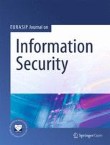In the last decades, a large number of techniques have been proposed to ensure integrity and authenticity of data in security-oriented applications, e.g. multimedia forensics, biometrics, watermarking and information hiding, network intrusion detection, reputation systems, etc.... The development of these methods have received a new boost in the last few years with the advent of Deep Learning (DL) techniques and Convolutional Neural Networks (CNNs) and, in most cases, the performance of DL-based methods greatly exceed those achieved by classical model-based and standard machine learning approaches. The dependability of these techniques, however, is questionable due to a number of shortcomings, some of which are particularly relevant in security-related applications. This Special Issue aims at providing a venue for research investigating strengths and limits of DL-based tools for security-related applications, and proposing more advanced and powerful tools that go beyond the state-of-the-art in the field.
Despite the initial gust of optimism brought by the advent of DL tools, DL-based approaches suffer from a number of shortcomings, many of which are particularly relevant in security-oriented applications, such as: the need for a huge amount of data representative of all the real word situations (that cannot all be foreseen at training time); the poor robustness to adversarial attacks; the difficulty of getting properly trained models which capture discriminative features without relying on confounding factors; etc.… Given the superior capabilities offered by DL tools, it is then worth to investigate the dependability of DL techniques for security applications, by revealing strengths and limits of DL-based tools, and proposing novel and more advanced approaches to overcome them.
- Adversarial Deep Learning, Adversarial examples in generative models
- DL understandability
- Secure DL classification/learning
- (applications-related) DL for multimedia forensics and counter-forensics
- Biometrics and authentication based on DL
- DL for watermarking and information hiding
- DL for steganography and steganalysis
- DL for network intrusion detection
Submission Instructions
Before submitting your manuscript, please ensure you have carefully read the submission guidelines for EURASIP Journal on Information Security. The complete manuscript should be submitted through the EURASIP Journal on Information Security submission system. To ensure that you submit to the correct special issue please select the appropriate special issue in the drop-down menu upon submission. In addition, indicate within your cover letter that you wish your manuscript to be considered as part of the special issue on Cyber Security Intelligence and Analytics. All submissions will undergo rigorous peer review and accepted articles will be published within the journal as a collection.
Deadline for submissions: 30 September 2019
Lead Guest Editor
Benedetta Tondi, University of Siena, Italy
Guest Editor
Mauro Barni, University of Siena, Italy.
Benedetta Tondi, University of Siena, Italy.
Slava Voloshynovskiy, University of Geneva, Switzerland.
Submissions will also benefit from the usual advantages of open access publication:
Rapid publication: Online submission, electronic peer review and production make the process of publishing your article simple and efficient
High visibility and international readership in your field: Open access publication ensures high visibility and maximum exposure for your work - anyone with online access can read your article
No space constraints: Publishing online means unlimited space for figures, extensive data and video footage
Authors retain copyright, licensing the article under a Creative Commons license: articles can be freely redistributed and reused as long as the article is correctly attributed
For editorial enquiries please contact denzel.victoria@biomedcentral.com.
Sign up for article alerts to keep updated on articles published in EURASIP Journal on Information Security - including articles published in this special issue!
